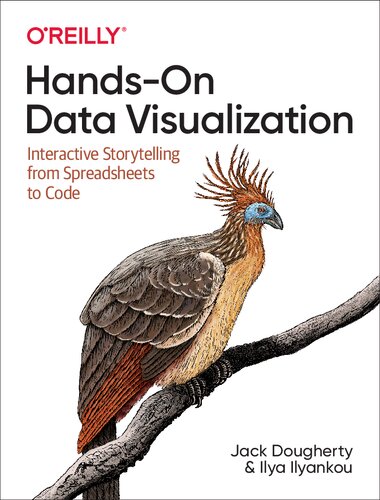| Book Name: | Hands-On Data Visualization: Interactive Storytelling From Spreadsheets to Code |
| Category: | Computer Books ( CE & IT ) |
| Free Download: | Available |
Hands-On Data Visualization: Interactive Storytelling From Spreadsheets to Code

Book Description:
Tell your story and show it with data, using free and easy-to-learn tools on the web. This introductory book teaches you how to design interactive charts and customized maps for your website, beginning with simple drag-and-drop tools such as Google Sheets, Datawrapper, and Tableau Public. You’ll also gradually learn how to edit open-source code templates like Chart.js, Highcharts, and Leaflet on GitHub.
Hands-On Data Visualization takes you step-by-step through tutorials, real-world examples, and online resources. This practical guide is ideal for students, nonprofit organizations, small business owners, local governments, journalists, academics, and anyone who wants to take data out of spreadsheets and turn it into lively interactive stories. No coding experience is required.
• Build interactive charts and maps and embed them in your website
• Understand the principles for designing effective charts and maps
• Learn key data visualization concepts to help you choose the right tools
• Convert and transform tabular and spatial data to tell your data story
• Edit and host Chart.js, Highcharts, and Leaflet map code templates on GitHub
• Learn how to detect bias in charts and maps produced by others
About the Author
Jack Dougherty is a Professor of Educational Studies at Trinity College in Hartford, Connecticut.
Ilya Ilyankou is an Independent Technologist. Ilya has been working with CTData Collaborative to build data visualization and data exploration tools for Connecticut for years.
Table of contents :
Preface
Audience and Overview
Advice for Hands-On Learning
Chapter Outline
Conventions Used in This Book
O’Reilly Online Learning
How to Contact Us
Acknowledgments
Introduction
Why Data Visualization?
What Can You Believe?
Some Pictures Are More Persuasive
Different Shades of the Truth
Organization of the Book
Summary
Part I. Foundational Skills
Chapter 1. Choose Tools to Tell Your Story
Start Sketching Your Data Story
Ten Factors When Considering Tools
1. Easy to Learn
2. Free or Affordable
3. Powerful
4. Supported
5. Portable
6. Secure and Private
7. Collaborative
8. Cross-Platform
9. Open Source
10. Accessible for Visually Impaired Readers
Our Recommended Tools
Use a Password Manager
Summary
Chapter 2. Strengthen Your Spreadsheet Skills
Select Your Spreadsheet Tools
Download to CSV or ODS Format
Make a Copy of a Google Sheet
Share Your Google Sheets
Upload and Convert to Google Sheets
Geocode Addresses in Google Sheets
Collect Data with Google Forms
Sort and Filter Data
Calculate with Formulas
Summarize Data with Pivot Tables
Match Columns with VLOOKUP
Spreadsheet Versus Relational Database
Summary
Chapter 3. Find and Question Your Data
Guiding Questions for Your Search
What Exactly Is the Question You’re Seeking to Answer With Data?
What Types of Organizations May Have Collected or Published the Data You Seek?
What Level(s) of Data Are Available?
Have Prior Publications Drawn on Similar Data, and, if so, How Can We Trace Their Sources?
What if No One Has Collected the Data You’re Looking For?
Public and Private Data
Mask or Aggregate Sensitive Data
Open Data Repositories
Source Your Data
Recognize Bad Data
Question Your Data
What Are Full Definitions for Abbreviated Column Headers?
How Exactly Was the Data Collected?
To What Extent Is the Data Socially Constructed?
What Aspects of the Data Remain Unclear or Uncertain?
Summary
Chapter 4. Clean Up Messy Data
Smart Cleanup with Google Sheets
Find and Replace with Blank
Transpose Rows and Columns
Split Data into Separate Columns
Example 1: Simple Splitting
Example 2: Complex Splitting
Combine Data into One Column
Extract Tables from PDFs with Tabula
Clean Data with OpenRefine
Set Up OpenRefine
Load Data and Start a New Project
Convert Dollar Amounts from Text to Numbers
Cluster Similar Spellings
Summary
Chapter 5. Make Meaningful Comparisons
Precisely Describe Comparisons
Normalize Your Data
Beware of Biased Comparisons
Summary
Part II. Building Visualizations
Chapter 6. Chart Your Data
Chart Design Principles
Deconstruct a Chart
Some Rules Are More Important Than Others
Chart Aesthetics
Google Sheets Charts
Bar and Column Charts
Grouped Bar and Column Charts
Split Bar and Column Charts
Stacked Bar and Column Charts
Histograms
Quick Histograms with Google Sheets Column Stats
Regular Histograms with Google Sheets Charts
Pie, Line, and Area Charts
Pie Charts
Line Charts
Stacked Area Charts
Datawrapper Charts
Annotated Charts
Range Charts
Scatter and Bubble Charts
Scatter Charts with Google Sheets
Bubble Charts
Tableau Public Charts
Scatter Charts with Tableau Public
Install Tableau Public and Connect Data
Create Scatter Chart in the Worksheet
Add Title and Caption, and Publish
Filtered Line Chart
Connect Data to Tableau Public
Build and Publish a Filtered Line Chart
Summary
Chapter 7. Map Your Data
Map Design Principles
Deconstructing a Map
Clarify Point-Versus-Polygon Data
Map One Variable, Not Two
Choose Smaller Geographies for Choropleth Maps
Design Choropleth Colors and Intervals
Choose Choropleth Palettes to Match Your Data
Choose Color Intervals to Group Choropleth Map Data
Normalize Choropleth Map Data
Point Map with Google My Maps
Symbol Point Map with Datawrapper
Choropleth Map with Datawrapper
Choropleth Map with Tableau Public
Current Map with Socrata Open Data
Summary
Chapter 8. Table Your Data
Table Design Principles
Datawrapper Table with Sparklines
Other Table-Making Tools
Summary
Chapter 9. Embed on the Web
Static Image Versus Interactive iframe
Get the Embed Code or iframe Tag
From Google Sheets
From Datawrapper
From Tableau Public
Paste Code or iframe to a Website
To WordPress.com Sites
To Self-Hosted WordPress Sites
For Squarespace, Wix, Weebly, or Other Web-Building Sites
Summary
Part III. Code Templates and Advanced Tools
Chapter 10. Edit and Host Code with GitHub
Copy, Edit, and Host a Simple Leaflet Map Template
Convert GitHub Pages Link to iframe
Create a New Repo and Upload Files on GitHub
GitHub Desktop and Atom Text Editor to Code Efficiently
Summary
Chapter 11. Chart.js and Highcharts Templates
Bar or Column Chart with Chart.js
Error Bars with Chart.js
Line Chart with Chart.js
Annotated Line Chart with Highcharts
Scatter Chart with Chart.js
Bubble Chart with Chart.js
Summary
Chapter 12. Leaflet Map Templates
Leaflet Maps with Google Sheets
Tutorial Requirements and Overview
Leaflet Storymaps with Google Sheets
Tutorial Requirements and Overview
Get Your Google Sheets API Key
Leaflet Maps with CSV Data
Leaflet Heatmap Points with CSV Data
Leaflet Searchable Point Map
Step 1: Prepare Your Data
Step 2: Download and Edit This Template
Step 3: Publish Your Map
Leaflet Maps with Open Data APIs
Summary
Chapter 13. Transform Your Map Data
Geospatial Data and GeoJSON
GeoJSON
Shapefiles
GPS Exchange Format
Keyhole Markup Language
MapInfo TAB
Find GeoJSON Boundary Files
Draw and Edit with GeoJson.io
Convert KML, GPX, and Other Formats into GeoJSON
Create GeoJSON from a CSV File
Create New GeoJSON Data with Drawing Tools
Edit and Join with Mapshaper
Import, Convert, and Export Map Boundary Files
Edit Data for Specific Polygons
Rename Data Fields
Remove Unwanted Data Fields
Simplify Map Boundaries to Reduce File Size
Dissolve Internal Polygons to Create an Outline Map
Clip a Map to Match an Outline Layer
Join Spreadsheet Data With Polygon Map
Count Points in Polygons with Mapshaper
More About Joins
Merge Selected Polygons with Join and Dissolve Commands
Convert Compressed KMZ to KML
Georeference with Map Warper
Bulk Geocode with US Census
Pivot Points into Polygon Data
Summary
Part IV. Telling True, Meaningful Stories
Chapter 14. Detect Lies and Reduce Bias
How to Lie with Charts
Exaggerate Change in Charts
Diminish Change in Charts
How to Lie with Maps
Examine Data and Upload to Datawrapper
Modify the Map Color Ranges
Recognize and Reduce Data Bias
Recognize and Reduce Spatial Bias
Summary
Chapter 15. Tell and Show Your Data Story
Build a Narrative on a Storyboard
Draw Attention to Meaning
Acknowledge Sources and Uncertainty
Decide on Your Data Story Format
Summary
Appendix A. Fix Common Problems
Tool or Platform Problems
Try a Different Browser
Diagnose with Developer Tools
Mac or Chromebook Problems
Watch Out for Bad Data
Common iframe Errors
Fix Your Code on GitHub
Index
About the Authors
Colophon
Hands-On Data Visualization: Interactive Storytelling From Spreadsheets to Code PDF
Author(s): Jack Dougherty, Ilya Ilyankou
Publisher: O’Reilly Media, Year: 2021
ISBN: 1492086002,9781492086000
Hands-On Data Visualization Book









![[PDF] Draw Buildings and Cities in 15 Minutes Draw Buildings and Cities in 15 Minutes pdf](https://www.freepdfbook.com/wp-content/uploads/2021/06/Draw-Buildings-and-Cities-in-15-Minutes-218x150.jpg)








![[PDF] Digital Image Processing An Algorithmic Introduction Using Java Digital Image Processing An Algorithmic Introduction Using Java](https://www.freepdfbook.com/wp-content/uploads/2022/06/Digital-Image-Processing-An-Algorithmic-Introduction-Using-Java.jpg)




![[PDF] 43 Years JEE ADVANCED + JEE MAIN Chapterwise & Topicwise Solved Papers 43 Years JEE ADVANCED (1978-2020) + JEE MAIN Chapterwise & Topicwise Solved Papers Physics PDF](https://www.freepdfbook.com/wp-content/uploads/2022/03/43-Years-JEE-ADVANCED-1978-2020.jpg)

![[PDF] Problems in Physical Chemistry for JEE (Main & Advanced) Problems in Physical Chemistry for JEE (Main & Advanced) Free PDF Book Download](https://www.freepdfbook.com/wp-content/uploads/2022/03/Problems-in-Physical-Chemistry-for-JEE-Main-Advanced.jpg)
![[PDF] Engineering Physics (McGraw Hill)](https://www.freepdfbook.com/wp-content/uploads/2021/05/bafc8c2685bb6823a9c56134f7fba5df.jpeg)

![[PDF] Engineering Chemistry By Shashi Chawla](https://www.freepdfbook.com/wp-content/uploads/2022/05/Theory-And-Practicals-of-Engineering-Chemistry-By-Shashi-Chawla-free-pdf-book.jpeg)
![[PDF] Chemistry: An Introduction to Organic, Inorganic & Physical Chemistry Chemistry: An Introduction to Organic, Inorganic & Physical Chemistry](https://www.freepdfbook.com/wp-content/uploads/2022/04/Chemistry-An-Introduction-to-Organic-Inorganic-Physical-Chemistry.jpg)
![[PDF] Essentials of Physical Chemistry Essentials of Physical Chemistry Free PDF Book by Bahl](https://www.freepdfbook.com/wp-content/uploads/2022/04/Essentials-of-Physical-Chemistry-bahl.jpg)
![[PDF] Biological control of plant-parasitic nematodes: soil ecosystem management in sustainable agriculture Biological control of plant-parasitic nematodes: soil ecosystem management in sustainable agriculture](https://www.freepdfbook.com/wp-content/uploads/2022/05/Biological-control-of-plant-parasitic-nematodes-soil-ecosystem-management-in-sustainable-agriculture.jpg)
![[PDF] Human Anatomy: Color Atlas and Textbook Human Anatomy: Color Atlas and Textbook Free PDF Book](https://www.freepdfbook.com/wp-content/uploads/2022/05/Human-Anatomy-Color-Atlas-and-Textbook.jpg)
![[PDF] Concepts of Biology Book [Free Download]](https://www.freepdfbook.com/wp-content/uploads/2022/05/Concepts-of-Biology.jpg)
![[PDF] Essentials of Biology [Free Download] Essentials of Biology Free PDF BOok Download](https://www.freepdfbook.com/wp-content/uploads/2022/05/Essentials-of-Biology-Free-PDF-Book-Downlaod.jpg)
![[PDF] Human Biology Book [Free Download]](https://www.freepdfbook.com/wp-content/uploads/2022/05/PDF-Human-Biology-Book-Free-Download.jpg)


